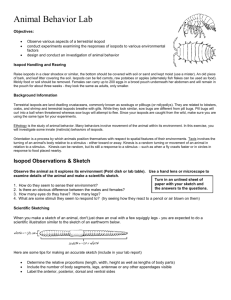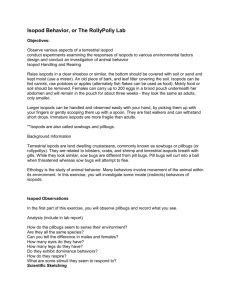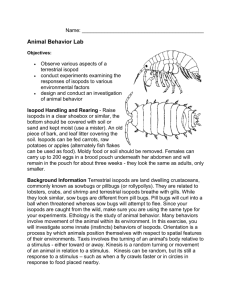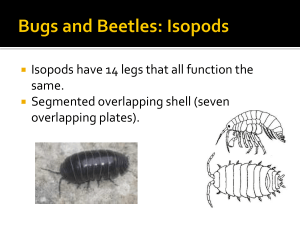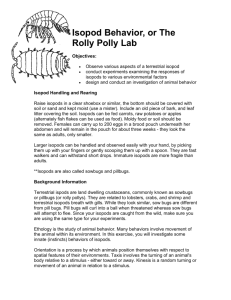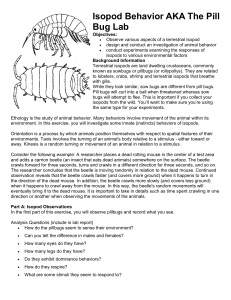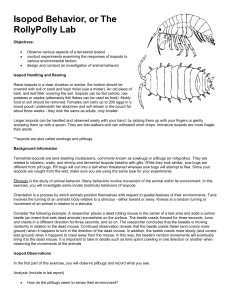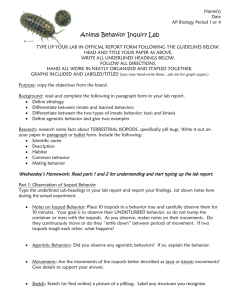A NEW HOST AND REPRODUCTION AT A SMALL SIZE FOR... CYMOTHOA EXCISA Lauren K. Joca , Vincent L. Leray
advertisement
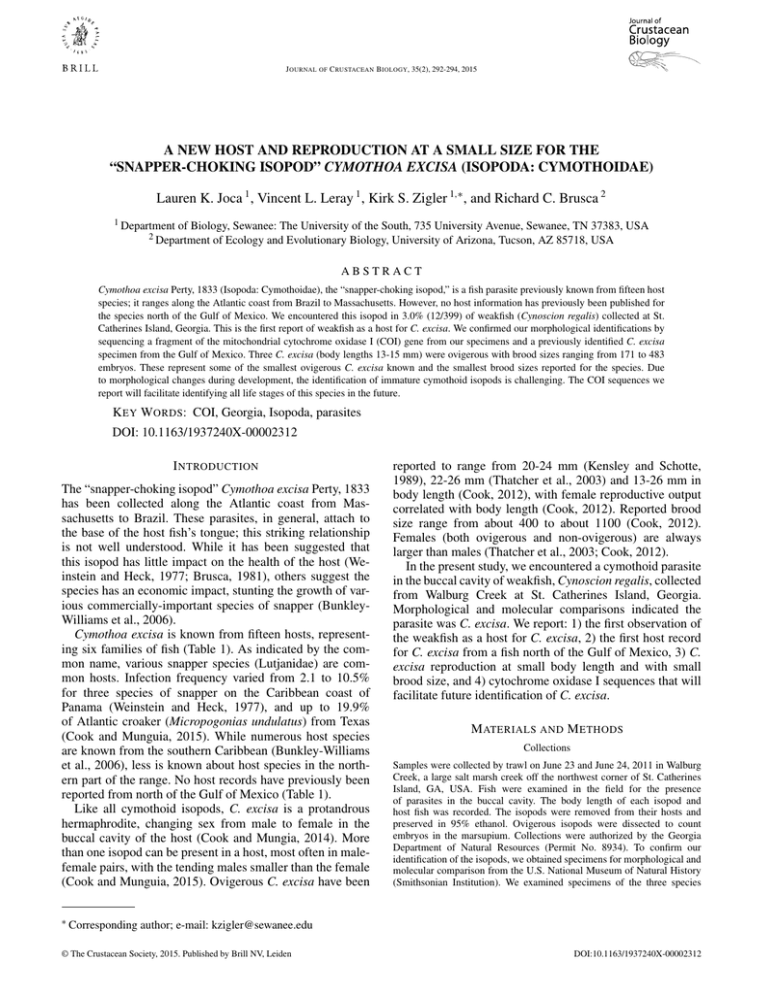
J OURNAL OF C RUSTACEAN B IOLOGY, 35(2), 292-294, 2015 A NEW HOST AND REPRODUCTION AT A SMALL SIZE FOR THE “SNAPPER-CHOKING ISOPOD” CYMOTHOA EXCISA (ISOPODA: CYMOTHOIDAE) Lauren K. Joca 1 , Vincent L. Leray 1 , Kirk S. Zigler 1,∗ , and Richard C. Brusca 2 1 Department of Biology, Sewanee: The University of the South, 735 University Avenue, Sewanee, TN 37383, USA of Ecology and Evolutionary Biology, University of Arizona, Tucson, AZ 85718, USA 2 Department ABSTRACT Cymothoa excisa Perty, 1833 (Isopoda: Cymothoidae), the “snapper-choking isopod,” is a fish parasite previously known from fifteen host species; it ranges along the Atlantic coast from Brazil to Massachusetts. However, no host information has previously been published for the species north of the Gulf of Mexico. We encountered this isopod in 3.0% (12/399) of weakfish (Cynoscion regalis) collected at St. Catherines Island, Georgia. This is the first report of weakfish as a host for C. excisa. We confirmed our morphological identifications by sequencing a fragment of the mitochondrial cytochrome oxidase I (COI) gene from our specimens and a previously identified C. excisa specimen from the Gulf of Mexico. Three C. excisa (body lengths 13-15 mm) were ovigerous with brood sizes ranging from 171 to 483 embryos. These represent some of the smallest ovigerous C. excisa known and the smallest brood sizes reported for the species. Due to morphological changes during development, the identification of immature cymothoid isopods is challenging. The COI sequences we report will facilitate identifying all life stages of this species in the future. K EY W ORDS: COI, Georgia, Isopoda, parasites DOI: 10.1163/1937240X-00002312 I NTRODUCTION The “snapper-choking isopod” Cymothoa excisa Perty, 1833 has been collected along the Atlantic coast from Massachusetts to Brazil. These parasites, in general, attach to the base of the host fish’s tongue; this striking relationship is not well understood. While it has been suggested that this isopod has little impact on the health of the host (Weinstein and Heck, 1977; Brusca, 1981), others suggest the species has an economic impact, stunting the growth of various commercially-important species of snapper (BunkleyWilliams et al., 2006). Cymothoa excisa is known from fifteen hosts, representing six families of fish (Table 1). As indicated by the common name, various snapper species (Lutjanidae) are common hosts. Infection frequency varied from 2.1 to 10.5% for three species of snapper on the Caribbean coast of Panama (Weinstein and Heck, 1977), and up to 19.9% of Atlantic croaker (Micropogonias undulatus) from Texas (Cook and Munguia, 2015). While numerous host species are known from the southern Caribbean (Bunkley-Williams et al., 2006), less is known about host species in the northern part of the range. No host records have previously been reported from north of the Gulf of Mexico (Table 1). Like all cymothoid isopods, C. excisa is a protandrous hermaphrodite, changing sex from male to female in the buccal cavity of the host (Cook and Mungia, 2014). More than one isopod can be present in a host, most often in malefemale pairs, with the tending males smaller than the female (Cook and Munguia, 2015). Ovigerous C. excisa have been ∗ Corresponding reported to range from 20-24 mm (Kensley and Schotte, 1989), 22-26 mm (Thatcher et al., 2003) and 13-26 mm in body length (Cook, 2012), with female reproductive output correlated with body length (Cook, 2012). Reported brood size range from about 400 to about 1100 (Cook, 2012). Females (both ovigerous and non-ovigerous) are always larger than males (Thatcher et al., 2003; Cook, 2012). In the present study, we encountered a cymothoid parasite in the buccal cavity of weakfish, Cynoscion regalis, collected from Walburg Creek at St. Catherines Island, Georgia. Morphological and molecular comparisons indicated the parasite was C. excisa. We report: 1) the first observation of the weakfish as a host for C. excisa, 2) the first host record for C. excisa from a fish north of the Gulf of Mexico, 3) C. excisa reproduction at small body length and with small brood size, and 4) cytochrome oxidase I sequences that will facilitate future identification of C. excisa. M ATERIALS AND M ETHODS Collections Samples were collected by trawl on June 23 and June 24, 2011 in Walburg Creek, a large salt marsh creek off the northwest corner of St. Catherines Island, GA, USA. Fish were examined in the field for the presence of parasites in the buccal cavity. The body length of each isopod and host fish was recorded. The isopods were removed from their hosts and preserved in 95% ethanol. Ovigerous isopods were dissected to count embryos in the marsupium. Collections were authorized by the Georgia Department of Natural Resources (Permit No. 8934). To confirm our identification of the isopods, we obtained specimens for morphological and molecular comparison from the U.S. National Museum of Natural History (Smithsonian Institution). We examined specimens of the three species author; e-mail: kzigler@sewanee.edu © The Crustacean Society, 2015. Published by Brill NV, Leiden DOI:10.1163/1937240X-00002312 293 JOCA ET AL.: SNAPPER-CHOKIING ISOPODS Table 1. Fish hosts for Cymothoa excisa. Records from Kensley and Schotte (1989), Bunkley-Williams et al. (1999, 2006), Thatcher et al. (2003), Cook and Munguia (2014), and this study. Family Species Common name Location reported Gerreidae Diapterus auratus Diapterus rhombeus Irish mojarra Caitipa mojarra Colombia Colombia Haemulidae Orthopristis chrysoptera pigfish Florida Lutjanidae Lutjanus analis mutton snapper Lutjanus griseus Lutjanus mahogoni Lutjanus synagris Ocyurus chrysurus gray snapper mahogany snapper lane snapper yellowtail snapper Colombia, Mexico, Panama, Venezuela Venezuela Panama Colombia, Panama Belize, Colombia, Mexico, Panama Priacanthidae Heteropriacanthus cruentatus glasseye Colombia, Panama, Venezuela Sciaenidae Cynoscion nebulosus Cynoscion regalis Leiostomus xanthurus Micropogonias undulatus Micropogonias furnieri Stellifer venezuelae spotted seatrout weakfish spot croaker Atlantic croaker whitemouth croaker Venezuelan stardrum Texas Georgia Texas Texas Colombia, Brazil Colombia Synodontidae Synodus foetens inshore lizardfish Texas No host recorded Massachusetts, South Carolina, Georgia, Bahamas, Cuba, Trinidad, Brazil of Cymothoa from the region: C. oestrum (Linnaeus, 1793), C. caraibica Bovallius, 1885 and C. excisa. Morphological Examinations Alcohol preserved specimens were observed under a dissecting microscope. The recent redescriptions of C. exisa and C. oestrum (Thatcher et al., 2003) and Kensley and Schotte (1989) were our primary resources. Our specimens have been accessioned into the National Museum of Natural History (USNM Nos 1265972-1265975). Molecular Methods and Analysis We used the standard protocol of the DNeasy Blood and Tissue Kit (Qiagen #69506) for DNA extraction. We used standard PCR conditions to amplify an approx. 600 bp fragment of the mitochondrial COI gene using the primers CymoF (5 -GCTGGGGTTGTAGGAGTAGC-3 ) and CymoR (5 TGTTGGAATAGAATAGGGTCTCC-3 ). We amplified an approx. 300 bp fragment from one museum specimen using the primers TentRev (5 TATACTGTTCATCCTGTTCC-3 ) and CymoF. All sequences have been submitted to GenBank (Accession Nos KP339864-KP339866). Successful PCRs were purified using the PCR Purification Kit (No. 28106; Qiagen). Purified PCRs were sequenced on both strands by the DNA Analysis Facility of Yale University. Sequences were examined and compared in Sequencher (version 4.9; Gene Codes, Ann Arbor, MI, USA). R ESULTS Out of a sample of 399 weakfish, 15 isopods were found in 12 fish – an infection rate of 3.0% (12/399). Three fish had two isopods in the buccal cavity. When two isopods were present the smaller male isopod was located farther back in the buccal cavity. Our sample contained three ovigerous females, nine non-ovigerous females, and three males. Host body length ranged from 4.4 to 11.8 cm. Isopod body length varied from 3.5 to 15 mm. Host body length and isopod body length were positively correlated (P < 0.001). Three isopods were ovigerous and they were dissected to determine brood size. Isopods of 13, 13, and 15 mm body length had brood sizes of 171, 312, and 483, respectively. Three males measured 5, 6.5, and 7 mm. Morphological comparisons suggested we had collected C. excisa. Notable features of our specimens were: 1) the anterior margin of the cephalon varied from truncate to slightly rounded, 2) large eyes that were somewhat degenerate, 3) the anterolateral angles of the pereonite 1 were variable, and 4) the pereiopods had high, rounded carinae. The exopod and endopod of the uropods differed depending on how much of a slight right-left distortion was present in the body. Molecular comparisons were consistent with the morphological identifications. We sequenced 555 bp of the COI gene of three individuals collected at St. Catherines Island and compared the sequences to a previously identified C. excisa from the Smithsonian collections (a specimen collected on 24 July 1965 from Panacea, Florida, identified by Thomas Bowman and deposited at the National Museum of Natural History; USNM No. 119784). Two individuals from St. Catherines (USNM No. 1265972) had identical sequences and the third differed by three nucleotides (<1% divergence). The specimen from Panacea, Florida yielded 271 bp of COI sequence. This individual differed by 2 bp (<1% divergence) from the more common St. Catherines haplotype. D ISCUSSION “Tongue-eating” isopods (Cymothoidae in the genus Cymothoa, and several other genera) are charismatic parasites, earning mention in popular science writing (Zimmer, 2001) and movies (thebay-movie.com). Although C. excisa 294 JOURNAL OF CRUSTACEAN BIOLOGY, VOL. 35, NO. 2, 2015 is known from the Atlantic coast of the United States, with collections reported from Massachusetts, South Carolina, Georgia and the Florida Keys (Kensley and Schotte, 1989; Prezant et al., 2002), prior to this study no host fish species were known from this region. We report Cynoscion regalis, the weakfish, as a new host for this region. Recent work clarified the life history of C. excisa (Cook, 2012; Cook and Munguia, 2015). Consistent with this work we found a positive correlation between host and isopod body lengths (Cook and Munguia, 2014). The ovigerous females we collected are some of the smallest known from C. excisa (Kensley and Schotte, 1989; Thatcher et al., 2003; Cook, 2012). Consistent with their small size, two of the ovigerous females had smaller broods (of 171 and 312 embryos) than any previously reported (Cook, 2012). Whether reproduction at such a small size relates to parasitization of this particular host or to the small size of the weakfish we collected remains to be determined. Further work on Cymothoa of the Caribbean and adjacent regions would be valuable. Three species (C. excisa, C. oestrum, and C. caraibica) have been described from the Caribbean. C. caraibica was recently synonymized with C. oestrum (Bunkley-Williams and Williams, 2003). We noted similarities between the descriptions of C. excisa and C. caraibica, suggesting further examination of species boundaries in these three species would be useful. Unfortunately, only a single specimen identified as C. caraibica is in the USNM collections and we were unable to amplify DNA from that specimen during this project. The identification of cymothoid isopods is complicated by changes in morphology during development. Beyond a change in sex, these ontogenetic changes include an increase in pleotelson width and decreases in gonopod length, eye perimeter, uropod perimeter and first antenna length (Cook and Munguia, 2015). As a result, species identifications are generally limited to large, ovigerous females (BunkleyWilliams and Williams, 2003). Molecular comparisons have been used to identify natatory stage cymothoid individuals from Australia (Jones et al., 2008) but sequences were not previously available for comparison with C. excisa. The COI sequences we provide here should simplify the identification of all life stages of C. excisa and could facilitate the study of host diversity across the broad range of the species. ACKNOWLEDGEMENTS We thank the St. Catherines Island Foundation for the opportunity to work on St. Catherines Island. F. Ferarri facilitated the loan of specimens from the Smithsonian Institution. C. Lambert provided helpful advice. This research was supported by Sewanee: The University of the South. R EFERENCES Bovallius, C. 1885. New or imperfectly known Isopoda. Bihang till Kongliga Svenska Vetenskaps-Akademiens Handlingar 10: 1-32. Brusca, R. C. 1981. A monograph on the Isopoda Cymothoidae (Crustacea) of the eastern Pacific. Zoological Journal of the Linnean Society 73: 117199. Bunkley-Williams, L., and E. H. Williams Jr. 2003. The identity of the seldom found Caribbean and Gulf of Mexico fish-parasitic isopod, Cymothoa caraibica Bovallius, resolved: a neoteric synonym of C. oestrum (L.). Carribean Journal of Science 39: 245-248. , , and A. K. Bashirullah. 2006. Isopods (Isopoda: Aegidae, Cymothoidae, Gnathiidae) associated with Venezuelan marine fishes (Elasmobranchii, Actinopterygii). Revista de Biología Tropical 54: 175188. , , and J. Garzon-Ferreira. 1999. Some isopod and copepod parasites (Crustacea) of Colombian marine fishes. Carribean Journal of Science 35: 311-314. Cook, C. W. 2012. The early life history and reproductive biology of Cymothoa excisa, a marine isopod parasitizing Atlantic croaker, (Micropogonias undulatus), along the Texas coast. Master’s thesis, Department of Marine Science of the University of Texas at Austin, 71 pp. , and P. Munguia. 2015. Sex change and morphological transitions in a marine ectoparasite. Marine Ecology, in press, DOI:10.1111/maec. 12144. Jones, C. M., T. L. Miller, A. S. Grutter, and T. H. Cribb. 2008. Natatory-stage cymothoid isopods: description, molecular identification and evolution of attachment. International Journal for Parasitology 38: 477-491. Kensley, B., and M. Schotte. 1989. Marine Isopod Crustaceans of the Caribbean. Smithsonian Institution Press, Washington, DC, 308 pp. Linnaeus, C. 1793. J. C. Fabricius, 1792-1794. Entomologia systematica emendata et aucta. . . adjectis synonymis, locis, observationibus, descriptionibus, 4 vols. Copenhagen. Perty, J. A. 1830. Delectus animalium articulatorum quae in itinere per Brasiliam annis 1817-20. . . collegerunt. . . J. B. de Spix . . . et . . . C. F. P. de Martius, digessit, descripsit, pingenda curavit M. Perty, Vol. 3. Monaco. Prezant, R. S., R. B. Toll, H. B. Rollins, and E. J. Chapman. 2008. Marine macroinvertebrate diversity of St. Catherines Island, Georgia. American Museum Novitates 3367: 1-31. Thatcher, V. E., G. F. Jost, and J. M. Souza-Conceição. 2003. Comparative morphology of Cymothoa spp. (Isopoda, Cymothoidae) from Brazilian fishes, with the description of Cymothoa catarinensis sp. nov. and redescriptions of C. excisa Perty and C. oestrum (Linnaeus). Revista Brasileira de Zoologia 20: 541-552. Weinstein, M. P., and K. L. Heck Jr. 1977. Biology and host-parasite relationships of Cymothoa excisa (Isopoda, Cymothoidae) with three species of snappers (Lutjanidae) on the Caribbean coast of Panama. Fishery Bulletin 75: 875-877. Zimmer, C. 2001. Parasite Rex: Inside the Bizarre World of Nature’s Most Dangerous Creatures. Atria Books, New York, NY, 320 pp. R ECEIVED: 31 July 2014. ACCEPTED: 20 December 2014. AVAILABLE ONLINE: 27 January 2015.
